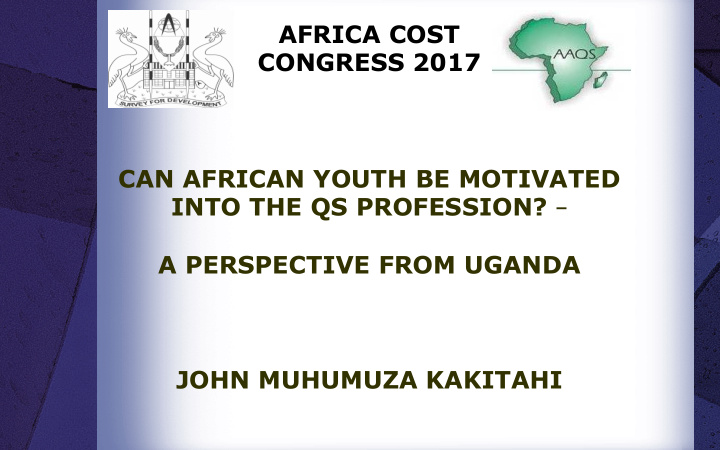



AFRICA COST CONGRESS 2017 CAN AFRICAN YOUTH BE MOTIVATED INTO THE QS PROFESSION? – A PERSPECTIVE FROM UGANDA JOHN MUHUMUZA KAKITAHI
Why ask the question? § What motivated me to become a QS? § Vision 2040 and NDP II ( see African Union’s Agenda 2063 Vision ) outline developments that require QS services § What is the current status of the profession in Uganda? In (East) Africa? § With an evolving profession, how can Youth ( 15-34 years ) be motivated to participate in the development as QSs?
In Context, What is motivation? Dependant ( initiation, direction and persistence ) variable influencing one to continue to work (Kooij, de Lange et.al ) § Initiation; driven by practitioners, who become mentors – the luminaries of QS § Direction; towards influencing a desired change in individuals, communities, etc. § Persistence; the cycle leading to “pool of QSs” living fulfilling/meaningful lives.
How can we be intentional about motivating the youth? Begin with examining our individual selves – the ideal self (Boyatzis, Boyatzis, et al). § Key construct driving our behaviours, emotions, perceptions and attitudes; § Psychological component both privately conceptualised and socially influenced; § Core mechanism of self-regulation and intrinsic motivation. .. accomplish in life / work? . personal vision?
Reviewing Literature and Contextualising to Uganda Apart from constructive self-examination, the “Big Picture” seemingly points to need for transformational change that involves: § Developing apt skills training programmes that blend with core QS § Providing mentorship training for selected luminaries of the profession § Establishing globally accredited reward systems, particularly for the mentors
Conducting the Study § Structured analysis of key documents from ISU, together with literature review § Situational analysis of the ISU through a basic audit and use of SWOT analysis § SWOT analysis scrutinized key identifiable political, economic, social and technical factors.
INTERNAL FACTORS INTERNAL FACTORS STRENGTHS (+) STRENGTHS (+) WEAKNESSES ( WEAKNESSES (–) Comprehensive vision, mission and strategic plan Feeble unifying work and social culture for members SWOT ANALYSIS STRATEGY FOR Skilled professionals with globally accepted competencies Inadequate financing for planned organizational activities MOTIVATION OF YOUTH INTO ISU Highly motivated organizational leadership Low strength and minimal impact of organization’s brand Increasing younger members to the organization Minimal collaboration with accredited tertiary institutions OPPORTUNITIES (+) OPPORTUNITIES (+) STRENGTHS (+) / OPPORTUNITIES (+) STRATEGY STRENGTHS (+) / OPPORTUNITIES (+) STRATEGY WEAKNESSES ( WEAKNESSES (-) / OPPORTUNITIES (+) STRATEGY ) / OPPORTUNITIES (+) STRATEGY Projected economic boom from Institute collaborative research initiatives with accredited tertiary Plan more social and community-inclusive activities for QS professionals national oil and gas sector institutions in East Africa in Uganda and East Africa. Planned regulatory reform to national Establish mentorship programs linking organization’s professional Incorporate training levies and statutory fees during regulatory reform construction industry members with students at tertiary institutions for increased funds for planned organizational activities Regional integration of labour markets Regularize mutual recognition agreements for East African QS High-impact rebranding of ISU as an organization with a long term in East Africa professionals and offer incentives for female enrolment strategy to mentor youth into the noble profession of QS EXTERNAL FACTORS EXTERNAL FACTORS Increased incentives for girls to enroll Collaborate with reputable QS entities such as RICS and, train QSs Planned regulatory reform to provide for reward schemes offered for into science-based courses within Uganda’s nascent oil and gas sector mentorship of youth at tertiary institutions Establish globally accredited reward Fast track the implementation of the organization’s strategic plan Curricula review of QS programs at tertiary institutions with a focus on schemes for professionals and periodically review achievements incorporating requisite vocational and technical skills THREATS ( THREATS (–) STRENGTHS (+) / THREATS ( STRENGTHS (+) / THREATS (–) STRATEGY ) STRATEGY WEAKNESSES ( WEAKNESSES (–) / THREATS ( ) / THREATS (–) STRATEGY ) STRATEGY Uncertain socio-political climate in the Seek continuous dialogue with government to facilitate informed Improved communication platforms that allow mentored youth East African region decision making for the construction industry participate in national development programmes Delayed implementation of mutual Establish continuous professional development programs for Organizational rebranding to be done in the East African region through recognition agreements African QSs in line with the AU Education Strategy the professional bodies and tertiary institutions Disparities in scales of fees across the Advocate for subsidies / tax exemptions for software and hardware Regularize mutual recognition agreements that facilitate standardization East African region from firms to tertiary institutions teaching QS of professional fees in the East African region Slow up skilling of professionals in Retooling / up skilling of QS professionals in BIM and sensitizing Institute training programs in new trends such as BIM, that are paid for new trends such as BIM them on evolving trends through automation by members as a way of raising funds for activities
SWOT ANALYSIS STRATEGY The Strengths / Opportunities Strategy § Collaborative initiatives with tertiary institutions ( academia-industry linkage ). § Mentorship programs linking professionals with students at tertiary institutions. § Mutual recognition agreements across East Africa and Africa and, incentives for female enrolment/participation as QSs.
SWOT ANALYSIS STRATEGY A selection of other mentioned strategies § CPD programs for QSs in line with the AU Education Strategy. § Advocate for subsidies/tax exemptions and/or other forms of incentives. § High impact rebranding of professional organisations; to mentor youth as QSs. § Improved communication platforms across organisations, nations, etc.
Summary extract on how to motivate Ugandan youth § Effective high-impact rebranding of the ISU; its place in region and Africa § Expeditious regulatory reform of the construction industry ( operationalising ) § Establish collaborative research initiatives with accredited institutions § Regularise mutual recognition agreements across Africa
Conclusion Motivating the youth into the QS profession can and should be done. What is our ideal? Be intentional; Be Generational THANK YOU
Recommend
More recommend